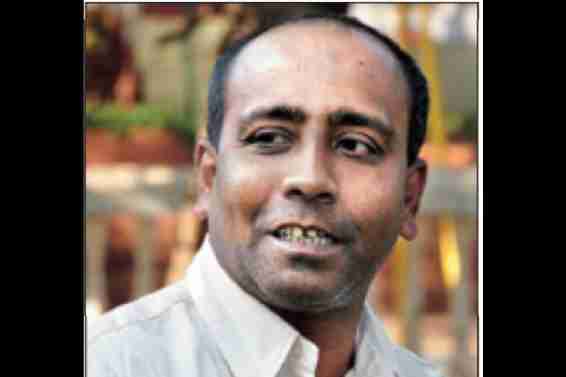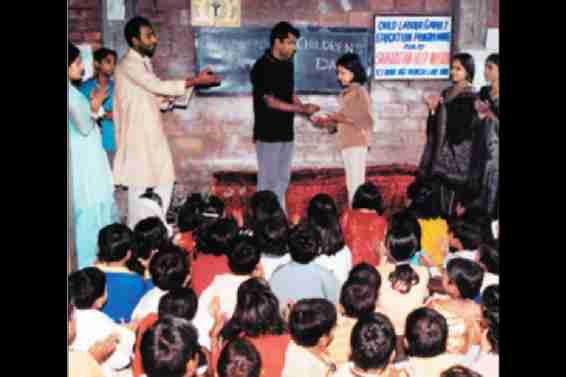Howrah, WEST BENGAL:
Moumita Chaudhuri meets Mamoon Akhtar, the good samaritan of Howrah’s Tikiapara and gets to know a lot about his social moves and motives.

Tikiapara is a downtown area in Bengal’s Howrah district, off NH22. Narrow lanes full of pedestrians and vans dangling dangerous iron rods and bars trundling through them, cars and bikes honking incessantly, piles of garbage and small iron manufacturing units. Amidst all of this stands Rebecca Belilious English Institution.
The English medium school is for the poor children of Tikiapara, Pilkhana and the neighbouring Bankra town.
Mamoon Akhtar is the principal and founder of the school. That day he is not in his office. He is attending to an elderly woman who is seeking a fee waiver for her ward. “The school fees are highly subsidised — Rs 100-150. Mamoon Sir believes that education should not be free. But if someone cannot pay, he will never turn a student down,” says Tapan Mandal, a member of the school staff.
The principal’s room has a single bed, a small sofa, a table and a chair. “Sir, spends his days and nights here,” says Mandal. “I have often spotted him sweeping the school premises at daybreak,” he adds.
Akhtar himself is a school dropout. After Class VII his father could not afford to pay the fees. However, he did not give up studying. “I started teaching primary students in my area and with that money completed my Class XII,” he tells The Telegraph.
Tikiapara in the 1990s and early 2000s was apparently a den of criminal activities.
Akhtar started his school with six children in 1999. “A room in my house a few hundred metres away from here, that was it,” he says. The story goes thus. One day, Akhtar was passing a slum when he saw a man was beating up a woman; she was refusing to sell drugs and he was egging her on. A little boy stood watching. When the brawl ended, Akhtar went up to the boy and told him he shouldn’t idle away his time and the boy said he would have liked to go to school except that nobody seemed keen to send him to one.
Akhtar asked the little chap to come to his house and he became his first pupil. Akhtar says, “The next day he came back with his friend. The third day, two more; on the sixth day, there were six children who wanted to study. I felt God was saying something to me. I cleaned up the front room of my mud house and started a school.”
There were no funds. Akhtar asked his students to bring old newspapers, broken items and discarded things from their homes or their neighbours’. He says, “I would sell the rags to the kabadiwala and with the money buy books, notebooks and stationery. I also requested the educated youth in the area come and teach. I paid them a small salary — Rs 100 per month.” The first funding for the school came from Lee Alison Sibley, the wife of the then US Consul General George Sibley. “I had seen her photograph in the newspaper and wrote to her asking for help for the school. Initially, she refused but she sent me a note appreciating my efforts. I wrote to her again and asked if she could help with some notebooks and pencils.” A few days after that, Lee visited the school with a journalist. She gifted a cheque of Rs 10,000 with which the school got its first toilet for the girl students.
Akhtar continues, “The journalist reported my story and one day I got a call from a Mumbai-based man called Ramesh Kacholia. He sent Rs 12,000 for cement flooring and windows. On completion, Akhtar found that he had spent Rs 8,000. He returned the rest to Kacholia.
The school was formally registered in 2007 as Samaritan Mission School High. By then, many organisations had come forward with grants. The Kacholia family stood by and connected Akhtar to Vidya Shah of Edelweiss Capital, an international investment company. These two associations have stood by the school and Akhtar through all these years. Once the school was in place, Akhtar turned to improving the living conditions of the people of Tikiapara. The students were from the nearby slums, children of labourers from Bihar and Uttar Pradesh. Their parents were auto drivers, domestic help, property dealers and so on. Most of the children were first-generation learners.

Once the school was in place, Akhtar turned to improving the living conditions of the people of Tikiapara. The students were from the nearby slums, children of labourers from Bihar and Uttar Pradesh. Their parents were auto drivers, domestic help, property dealers and so on. Most of the children were first-generation learners.
Akhtar started a vocational training programme for women. The Howrah police and the administration too supported his endeavours.
In 2014, the wheels turned for Akhtar. The Rebecca Belilious English Trust of Howrah handed over their school building and clinic to him. “It belonged to a Jewish family by the name of Rebecca Belilious,” he says.
The building was renovated with funds from corporates. Akhtar named the five floors of the school building after Savitribai Phule, C.V. Raman, Swami Vivekananda, Ishwarchandra Vidyasagar, B.R. Ambedkar and Baba Amte. The clinic at the Rebecca Institute has now been turned into a small hospital that caters to the people of Tikiapara. Soon there will be a hostel for girls; Akhtar feels the slums in the neighbouring area are not safe for girls. A galpo ghor or storytelling room will start for the children of the primary school as they still do not have a library.
Akhtar’s first school has also gotten better — smart classrooms, science and computer labs, sports such as archery, basketball, football are encouraged. Children can also opt for NCC training. In 2015, Akhtar opened a third school named Samaritan Public School in the slums of Bankra in Howrah.
Students from his first school cracked the 2022 NEET examinations and one student qualified in the WBJEE exams last year. From six students, the number of children attending these three schools is now 6,300.
source: http://www.telegraphindia.com / The Telegraph Online / Home> Culture / by Moumita Chaudhuri / July 23rd, 2023








